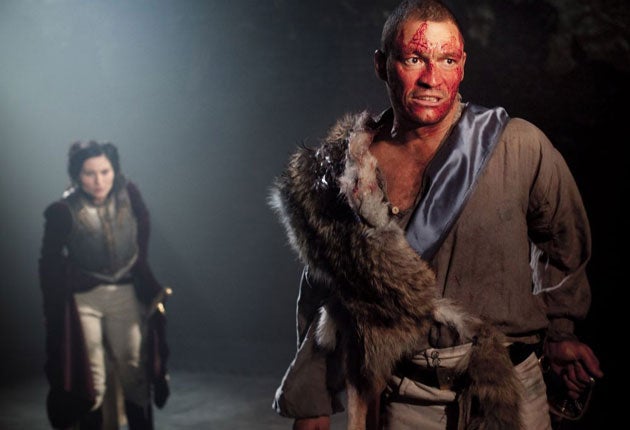Life is a Dream, Donmar Warehouse, London

Have you heard the Chinese sage's story about the man who dreamt he was a butterfly and then woke up to wonder if he was, in fact, a butterfly dreaming he was a man? A compelling variation on this theme of the confusion between illusion and reality is dramatised in Life Is a Dream, the 1635 play by the great golden age Spanish dramatist, Calderó*de la Barca. Set in Poland, the play focuses on Segismundo, the young heir to the throne who has spent his life imprisoned in a tower because omens foretold that he would one day overthrow his father, the king. As in Oedipus Rex, this paternal insurance policy backfires. The monarch's neurotic desire to outwit fate is itself outsmarted by circumstance, although here a very qualified happy ending is reached.
The brilliance of the piece lies in its twists that entwine the existential and the political. Anxiety over the succession prompts a change of heart in the king who decides to conduct an experiment. The ragged, radically unsocialised Segismundo is drugged and dumped in court where he revives to a baffling new identity as a spankingly uniformed king. The wild youth flunks his father's test, though, by defenestrating a servant and trying to molest one of the noblewomen. It's only after he's released a second time by rebels supporting his claim to the throne that he starts to get a grip on his predicament and use it to his own (eventually somewhat dubious) ends.
In Jonathan Munby's vivid, shrewd, if slightly disappointing revival at the Donmar, the hero is played by Dominic West. He brings charisma and clarity to the role but also insufficient instability and, to my mind, the wrong kind of physical presence. This Segismundo is a strapping hunk who looks as if he's on leave from an Olympic rowing team rather than from a lifetime of incarceration. When George Anton took the part for bad-boy director, Calixto Bieito, he was almost feral, sniffing hungrily like an animal at his wondrous new surrounding and masturbating at the memory of it all back in his lonely cell. By comparison, you feel that West would be relatively easy to house-train. He scores better at tracing the hero's intellectual development. The wonderful, liberated gleam in his eye acutely registers the sizzle in the synapses when he suddenly realises that if the whole of life is a dream, you might as well go for broke and be the star of it.
The heart sinks a little at the start as the cast stamp their heels flamenco-fashion to evoke a headlong gallop. The objection is not that this is Poland, where the flamenco never caught on, because with its rigid honour-code, Calderón's Poland is Spain in everything but fact. It's that, by common consent, English actors can't ape the Hispanic without looking like chumps. The muezzin-like wails are fine, but the over-pitched melodramatic acting mars the convoluted (faintly tedious) restoration-of-female honour ancillary plot. The play is as good as it gets, though only in parts.
But the production does have a fine, diagrammatic lucidity with regard to the vital themes. On three linked occasions, for example, a chained prisoner is slumped centre-stage. The first of these is Segismundo. The second is Lloyd Hutchinson's clownish Irish servant whose manner of death (in cowardly flight, he runs straight into a bullet) is a miniature parody of the king's pusillanimous, backfiring stratagem. The third, chillingly, is one of the rebel soldiers who sprang Segismundo from prison. Freshly installed as king, the hero chooses, with all the arbitrary perversity of a born-again realpolitiker, to interpret his own liberation as an act of treachery. It suggests that, for some in this new regime, life may soon turn into a nightmare.
To 28 November (0844 871 7624)
Join our commenting forum
Join thought-provoking conversations, follow other Independent readers and see their replies
Comments